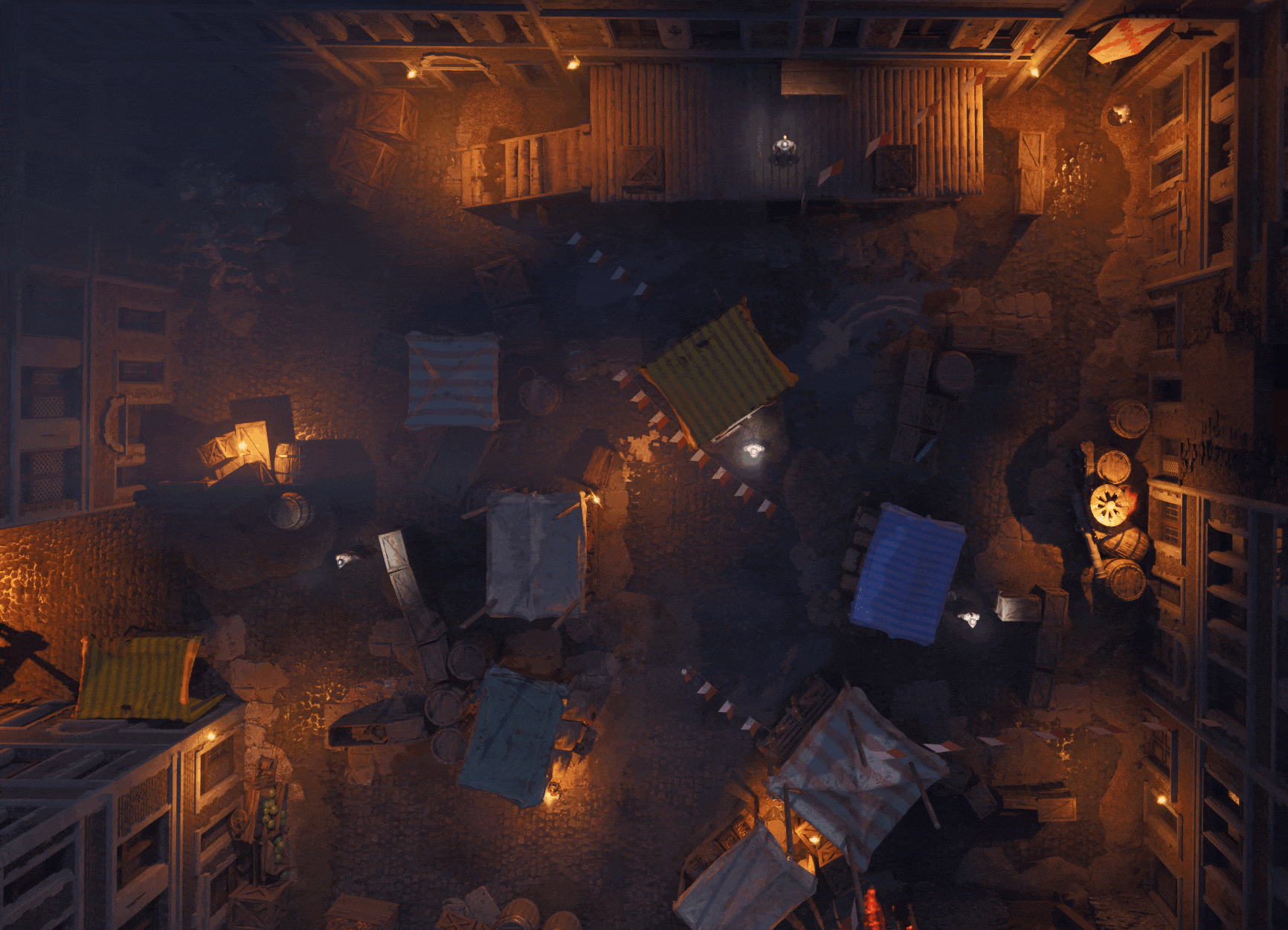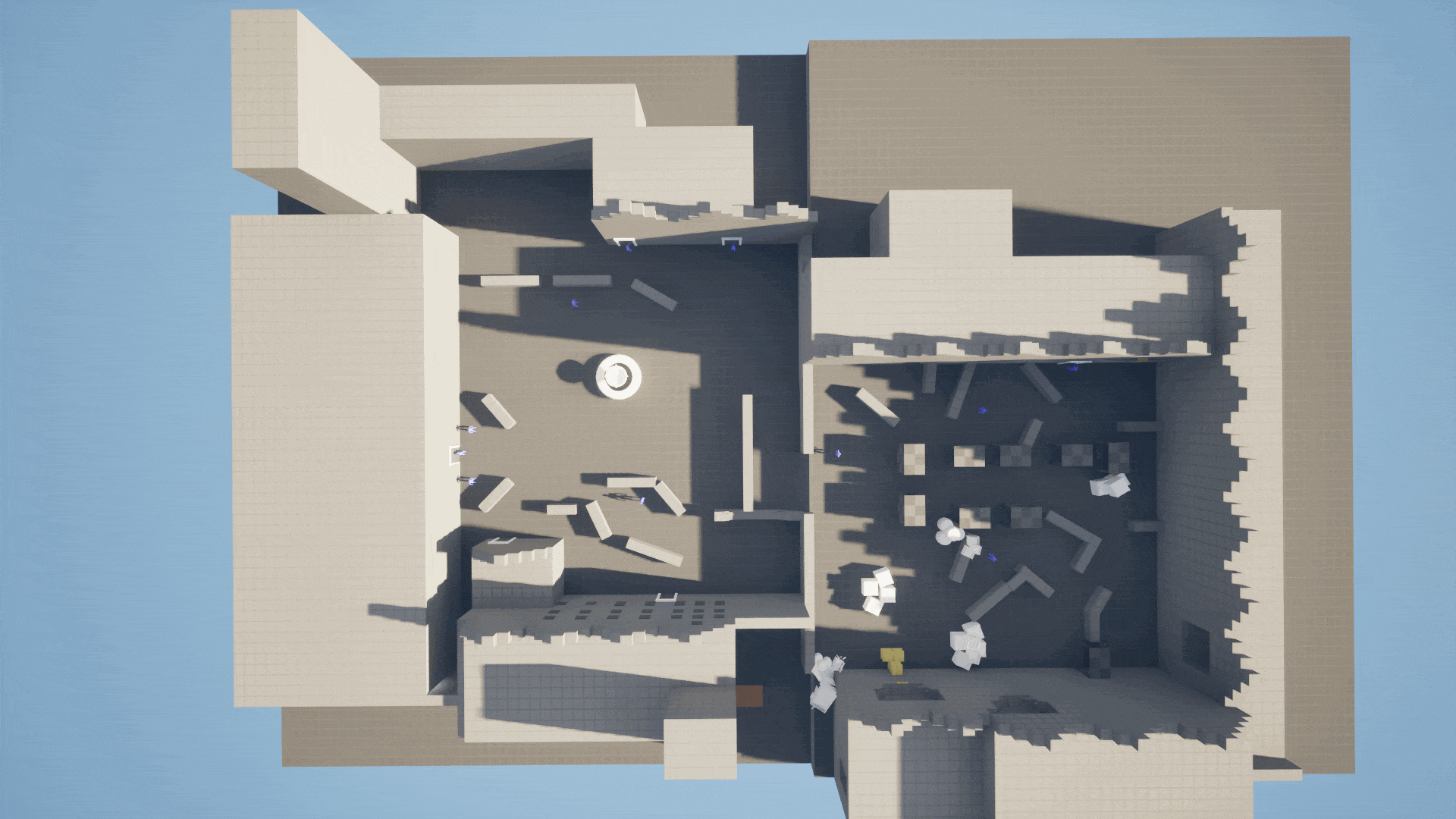Rik Boerma - Level / Game Designer
SICARIA
ROLE
Level Designer
GENRE
Stealth
MADE WITH
Unreal Engine 5
Sicaria is a stealth game set in Antwerp during the 80 Years War, when the Netherlands rose up against Spain. The game was built on the core pillars of this setting, as well as tactical, "prowler"-style stealth gameplay.
I was responsible for designing the market level of the game, being tasked with ensuring that it would live up to these pillars.
Sicaria was a finalist in the Best Student Game category of the Game Development World Championship.

Setting Up Encounters
Player Awareness of Enemies
In Stealth games, it is crucial that players quickly and intuitively understand where enemies will patrol, so that the player can anticipate and plan their movements. I employed several techniques to achieve this:
-
I set up enemy patrol points along barricades to intuitively indicate the enemy's zone of control to the player, inspired by other Stealth games such as Splinter Cell: Blacklist and A Plague Tale: Requiem.

-
I used lights to cast the enemy's shadow on walls in places where the player might not be able to see the enemy, inspired by Sniper Elite 5.

Event Triggers
To further facilitate players seeing the enemies, I set up several triggers around the level to enable enemy movement only when the player reached those triggers, thereby ensuring the player can properly see the enemy before they move.
See the video on the right for an example where two enemies start moving as the player reaches the top of the stairs, with one of them opening a door to let the player know the enemy is roaming around in that room.
Guidance
Lighting
Because of the nighttime setting, lighting was a crucial method of guiding the player around the level. To this end, lights were set up to highlight the main goals for the player, as well as alternative paths to reach those goals.

Scripted Events
The final segment of the level features a wall that initially represents a dead end to the player but gets blown up after the player interacts with the mission objective. To make this event clear to the player, I used a camera sequence to show the wall being blown up.
Signposting
In addition to lighting, I used several forms of signposting to help guide the player where to go, like the Spanish banner in the screenshot on the right. I asked an artist to make this specific prop as not only does the pointy bottom create an arrow shape pointing to the archway the player needs to pass through, the red cross on the white background also easily stands out from the environment.


Planning & Level Layout
One-pager
I made the one-pager on the right to visualize and describe my vision for the level, allowing me to quickly get feedback and iterate on the design before starting the blockout.
The one-pager includes important information like the design purpose of the level, the player goal and the overall mood, as well as a legend. As this level section takes place after the initial onboarding section, the main purpose of this section was to provide a more open-ended experience, where the player needs to apply what they've learned so far to make their own way through the level.
Layout
From the one-pager the level went through many iterations before arriving at the final design below. However, one design goal that remained constant was to structure the level in 4 zones (Safe Zone, Buffer Zone, Enemy Zone, Goal), inspired by other stealth games, most notably A Plague Tale: Requiem.
-
Safe Zone: Player starts from here and can safely observe enemies and plan their movement.
-
Buffer Zone: Player canstill hide behind cover for relative safety but is getting closer to the enemies and may get spotted if they're not careful.
-
Enemy Zone: This is where enemies patrol and the player must be careful and time their movements well, making good use of cover options to avoid enemy detection. In line with the design goal, this section is large and open, letting the player find different ways around the central square.
-
Goal: Lies on the other side of the enemy zone.
-
Side Path: To reinforce the level's open design and reward the player for keen observations, this alternative route provides an alternative gameplay dynamic with more climbing and interior spaces rather than the open yet densely covered enemy zone.


Iterating
Iterations - Downscoping
The level changed a lot from the concept of the one-pager. Most notably, the level was drastically reduced in size to accomodate the limited time available for setdressing.

Iterations - Encounter Tweaking
Throughout the project, I constantly playtested the level and used the feedback to tweak the encounters in small but important ways, for instance by adjusting enemy pathing or cover set up. An example of this can be seen in the screenshots below.


Unused Blockout
Het Steen blockout
Early on in the project, I analyzed recognisable locations in the city of Antwerp that we could adapt and made a blockout level based on Het Steen, a medieval fortress that is still standing today. I visited the fortress itself in Antwerp and also researched its history, based on which I added market stalls and a wall segment that is gone now. The level was eventually cut due to scope concerns but still proved to be a worthwhile exploration.
Even in this early stage, I built the level with a focus on building multiple paths that offer different gameplay styles, with some paths offering more climbing gameplay, interior sections or a more dangerous head on approach.




Setting Up Pipelines
Establishing Data Layer Pipelines
To facilitate the work of level designers and environment artists and to help with performance, I researched the World Partitioning system in Unreal Engine 5. As part of this, I set up a pipeline for a subsystem called Data Layers, allowing us to (un)load chunks of the level at specific triggers, helping with performance.
In addition, it allowed artists to work on top of the blockouts that level designers made without deleting said blockouts, as they would be unloaded in the game anyways. This way, we could always refer back to them when needed.

Takeaways
Working on a longer project in a bigger team (relative to my other university projects), as well as designing my first stealth game, has taught me a lot, including:
-
Working with custom AI was a very valuable experience in overcoming the unique challenges it presents, collaborating closely with the AI team, requesting features and fixes, adjusting the level design around the AI limitations and performing extensive testing.
-
As a stealth game, this project also presented a unique level design challenge, as in a game like this, you want to slow the player down through level design. Finding the middle ground between players being able to run past all the enemies and the player getting bored by waiting requires careful thinking about cover placement and enemy pathing, timing and zones of control.
-
Don't be afraid to take a step back, experiment and rethink the level from scratch. I iterated a lot on the level over time but looking back, I think I could have gotten a lot out of restarting the level and experimenting more. Frequent deadlines and the need to present a playable level significantly constrained this possibility but I think it could have benefited the quality of the final level.
-
Although it is important to consider big decisions carefully, postponing decisions too long can also be counterproductive. With a larger team and more time, decisions often took longer to make, especially when they were controversial. In the end, this often made things worse, as there was unclarity about these decisions and people continued working on features that ended up getting cut anyway.